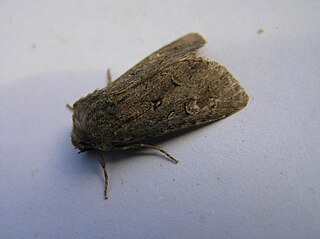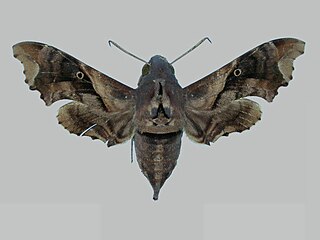
The grey pug is a moth of the family Geometridae. It is found throughout the Palearctic region. It is also found in North America. Since it does not place any special demands on climatic conditions, special caterpillar food plants, geological subsoil or the like it is a typical species of almost any Hochstaudenflur, where it occurs in the herb layer, in bushes and even on deciduous trees. It can be found on forest edges and hedgerows, on heath, in rocky places and wetlands, parks and gardens, as well as in villages and town centres.

The goldenrod pug is a moth of the family Geometridae. The species was first described by Henry Doubleday in 1861. It is found throughout the Palearctic region. In the British Isles it is widespread but rather locally distributed.

The nutmeg, also known as the clover cutworm, is a moth of the family Noctuidae.

The dark pewee is a small passerine bird in the tyrant flycatcher family. It is endemic to the Talamancan montane forests of Costa Rica and western Panama.

Luperina testacea, the flounced rustic, is a moth of the family Noctuidae. It is found in Europe, Asia Minor and Armenia.

Tiliacea citrago, the orange sallow, is a species of moth of the family Noctuidae. It is found in Europe as far east as the Caucasus Mountains and the Urals.

Anaplectoides prasina is a species of moth of the family Noctuidae. It is found in both the Palearctic and Nearctic realms.

Xanthia gilvago, the dusky-lemon sallow, is a moth of the family Noctuidae. The species was first described by Michael Denis and Ignaz Schiffermüller in 1775. It is found in Europe.

Eupithecia venosata, the netted pug, is a moth of the family Geometridae, first described by the Danish zoologist Johan Christian Fabricius in 1787. It is found across the Palearctic realm from Portugal and Morocco in the west to the Lake Baikal in Siberia and Afghanistan and Pakistan in the east.

Enyo boisduvali is a moth of the family Sphingidae. It is known from Cuba.
Eupithecia sibylla is a moth in the family Geometridae. It is found in the regions of Los Gatos, Antofagasta, Atacama, Coquimbo, Valparaiso, Santiago, O'Higgins, Maule and Biobio in Chile. The habitat consists of the Northern Desert, Northern Coast, Intermediate Desert, Coquimban Desert, Central Andean Cordillera, Central Valley, Valdivian Forest and the Northern Valdivian Forest biotic provinces.
Eupithecia zagrosata is a moth in the family Geometridae. It is found in Iran.
Eupithecia indissolubilis is a moth in the family Geometridae. It is found in the Shaanxi province of China, and in parts of Russia. It has been found at altitudes between 1100 and 1700 meters. Adults are on wing from early June to early July.
Eupithecia melanograpta is a moth in the family Geometridae. It is found in Peru.
Eupithecia rufivenata is a moth in the family Geometridae. It is found in Peru.
Eupithecia sylpharia is a moth in the family Geometridae. It is found in Brazil.
Eupithecia tenuiscripta is a moth in the family Geometridae. It is found in New Guinea.
Eupithecia trigenuata is a moth in the family Geometridae. It is found in Peru.
Eupithecia venulata is a moth in the family Geometridae. It is found in Peru.
Eupithecia yangana is a moth in the family Geometridae. It is found in Ecuador and Peru.









